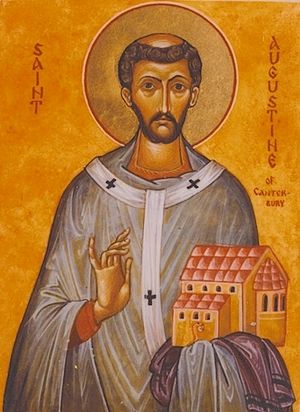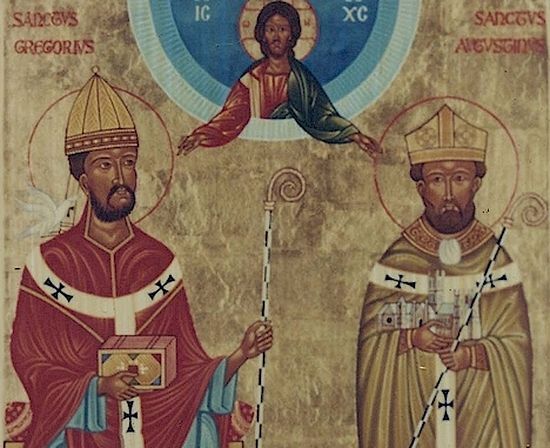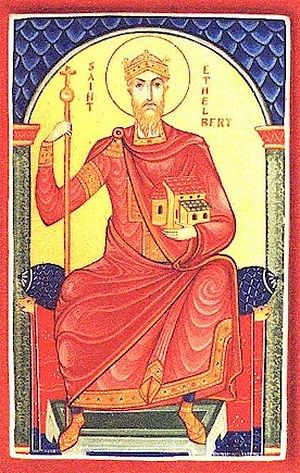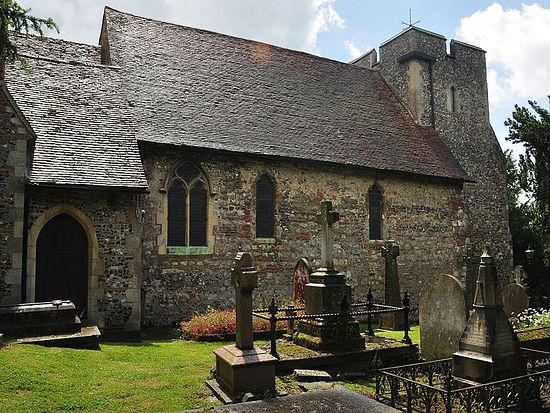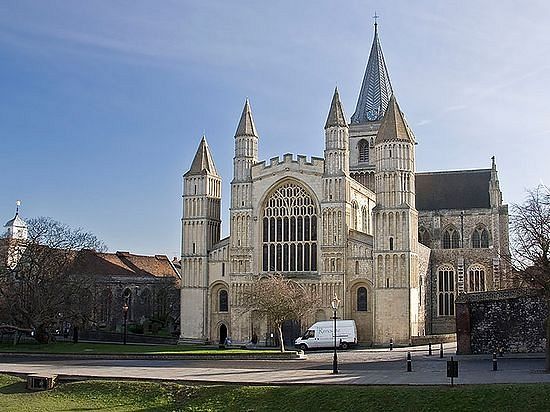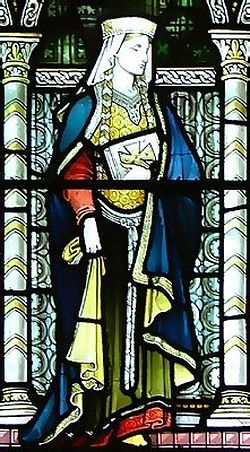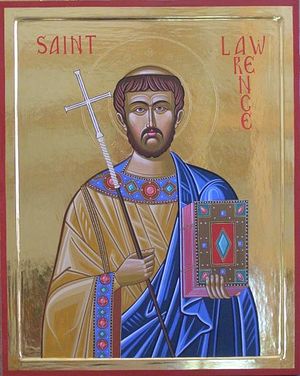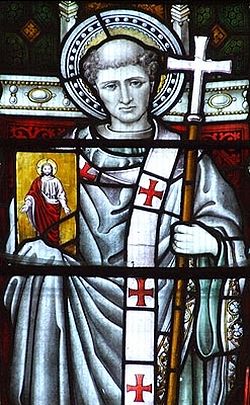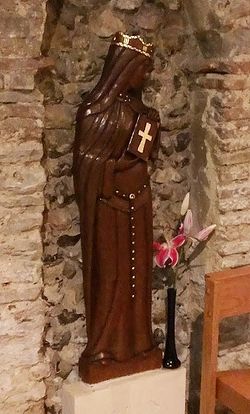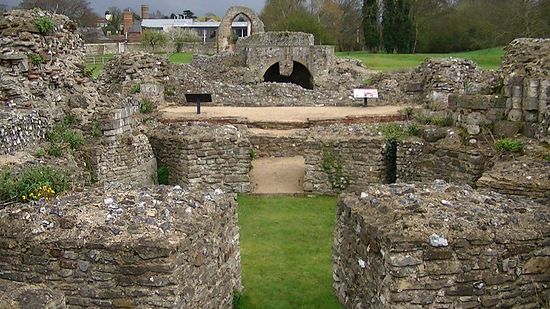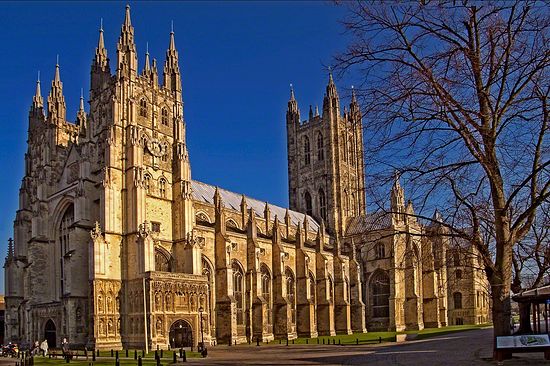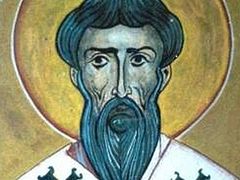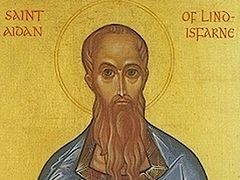Together with St. Gregory the Dialogist (Gregory the Great, according to the Western tradition), the Pope of Rome, St. Augustine (also Austin) is venerated as “the Apostle of the English”. He was most probably born in Sicily in the mid-sixth century and became a friend of the future Pope Gregory. In his youth St. Augustine led the monastic life at St. Andrew’s monastery in Rome, which had been founded by St. Gregory, and later became its prior (the abbot’s assistant; with St. Gregory as its abbot). St. Gregory praised Augustine for his brilliant knowledge of the Scriptures and excellent administrative abilities.
Around the year 596 St. Gregory sent Augustine at the head of the mission of forty Italian monks to England. The history of this crucial mission of English and even European history is well-documented and, specifically, described by Venerable Bede in his History of the English Church and People. The prehistory of this mission is also remarkable. Once St. Gregory happened to visit a slave market in Rome where he spotted three young male slaves with fair hair from northern England. He asked the slave trader who they were and where they came from. The latter answered that they were Angles and brought from Deira (then a kingdom in northern England). The future Pope with all his heart wished that these Angles would became like angels and come from the wrath of God (“de ira” in Latin) to eternal bliss.
So, when the time came, St. Gregory decided to fulfil his great ambition: to re-establish Orthodox Christianity in the now English land (we use here the word “re-establish” knowing that Christianity had existed in Britain during the Roman occupation perhaps from the first century till 410—when the Roman legions withdrew from Britain—but soon after almost completely and rapidly disappeared until the Augustinian mission; while in Wales, Dumnonia,1 Ireland, and Scotland, inhabited by Celtic peoples, a developed Church and monastic life was already flourishing by that time).
On their journey to Albion the missionaries stopped in Gaul, present-day France, where, it is said, St. Augustine performed his first miracle in Anjou: through his prayers a well with miraculous properties gushed forth there. The companions first stopped at the famous Lerins monastery in southern Gaul. Monks in Gaul told the missionaries about the life and customs of the Angles, especially that they were for the most part ferocious and cruel heathen. The fellow-missionaries of Augustine were scared and rather hesitant to go ahead, so it was decided to send St. Augustine back to Rome and ask the Pope Gregory what they should do further. The Pope encouraged Augustine, blessed him to go back, and commanded other brethren not to lose heart, but to go forward without any hesitation. He promised to pray hard for the success of their mission.
In spring 597 the Italian monks, accompanied by a number of Frankish priest-interpreters, arrived on the shores of Kent in the south-easternmost corner of England. According to tradition, they landed in or very near Ebbsfleet in Kent, on the Isle of Thanet which then was separated from the mainland England by a small river or channel, but now is part of the mainland (a memorial cross still stands on the site to commemorate the arrival of the missionaries). At that time Kent was the most influential of all the early English kingdoms and it had mostly been settled by the Germanic tribe of Jutes.
From the year 562 Kent had been ruled by the pagan Ethelbert (later to become St. Ethelbert). Fortunately, his spouse, Queen Bertha—a Frankish princess—was a Christian. Kent had permanent trade links with Gaul and communication with the continent and the Christian world, unlike other local kingdoms. Born in Gaul, Bertha had agreed to marry Ethelbert on condition that she was allowed to practice her Christian faith in England and to take her confessor, the priest Liudhard (+ c. 603) with her. Not only did Ethelbert consent to this condition, but even provided her with a small and ancient church of St. Martin of Tours in Canterbury (though it has since been rebuilt, this very ancient church, which is about 1700 years old, survives to this day).
King Ethelbert knew about the Christian faith and thus received St. Augustine very kindly, but at the same time with caution. He did not invite the saint to his palace, but preferred to talk with him “under an oak tree”, obviously hoping in this way to protect himself from “Christian magic”. The royal residence of the Kentish king was situated in Canterbury, which then was called Durovernum. Tradition tells that the first official meeting between the King and Augustine took place in Richborough near Ramsgate on the Isle of Thanet. Augustine was accompanied by his monks: all of them sang beautiful Christian hymns, and welcomed the king with a large silver cross and a large icon of Christ the Savior.
Ethelbert was impressed by the look of the monks and by their speech. There St. Augustine preached his first sermon to Ethelbert through an interpreter, and a chapel was later built there to commemorate the event. St. Ethelbert was more interested in Christ, though confessed he was not yet prepared to embrace the new faith. However, he allowed Augustine and all his brethren to be accommodated in Canterbury (the capital of Kent), to preach Christianity among his subjects freely, and provided them with the church of St. Martin.
According to tradition, on Pentecost Sunday of the same year, 5972, King Ethelbert was baptized at St. Martin’s church, together with many representatives of his nobility. Soon afterwards some 10,000 people of Kent voluntarily resolved to follow their ruler and be illumined by holy baptism. The mass baptism took place in the small River Swale in Kent. It was the first mass conversion to Orthodoxy in the English part of post-Roman Britain. This remarkable event was accompanied by numerous healings and miracles. It is noteworthy that neither Augustine nor King Ethelbert forced any of them to accept baptism—it was the voluntary decision of the people. Among those baptized were Jutes, Angles and Saxons. The monks began to live in Canterbury near the present-day Staplegate, to fast, pray, keep vigil, imitate Christ in their life, to go out to the people and preach the Good News to them. Soon further miracles followed. It was evident that the abundant grace of God had descended on this corner of the future England.
Meanwhile, in the following year of 598, St. Augustine travelled to Gaul for a short time where he was consecrated archbishop. Thus, he became the first Archbishop of Canterbury and primate of the English Church. The city of Canterbury ever since has been considered to be the English ecclesiastical capital. On account of his success in his mission in Kent and partly in neighbouring parts of England, St Augustine has been regarded as the enlightener of the Angles, and he shares this title with St. Gregory. Among the monks who came with Augustine to England there were several other saints: St. Laurence, the second Archbishop of Canterbury (+ 619); St. Honorius, the fifth Archbishop of Canterbury (+ 653); St. Peter, the first Abbot of Canterbury (+ 607); and, probably, St. James (d. late seventh century), an illustrious deacon in York. In the year 601 new missionaries were sent from Rome by St. Gregory, some of whom later became saints as well: the future St. Mellitus, third Archbishop of Canterbury (+ 624); St. Justus, the fourth Archbishop of Canterbury (+ 627); and St. Paulinus, the first Bishop of York (+644). They brought relics, liturgical books, church vessels and vestments from Rome.
St. Augustine founded his Cathedral in Canterbury and dedicated it to Christ the Savior. It was said that an earlier church had existed on the same site, perhaps from Roman times. The present Canterbury Cathedral, the main Cathedral of the Church of England, is the successor of the Cathedral founded by St. Augustine. It is known that the archbishop began building a monastery in honor of Sts. Peter and Paul near the walls of Canterbury, which was completed after his repose. That was the first monastery in England. In Canterbury St. Augustine also built a school where many Christians of that period came to study, and produced many future saints and Church figures. A generation after St. Augustine’s repose this school had already sent missionaries to help enlighten the Kingdom of the East Angles.
St. Peter, mentioned above, became the monastery’s first abbot; but he unfortunately drowned during his journey to Gaul in 607 near Ambleteuse, not far from Boulogne, where his relics are still venerated. Among old Christian churches restored by Augustine in Canterbury let us mention the church of St. Pancras (an early Orthodox boy-martyr in Rome, some of whose relics were later translated to England, where, for example, one of London’s railway stations is called St. Pancras in his honor to this day). Of this once splendid church only ruins survive today.
St. Augustine also founded the diocese of Rochester in the kingdom of Kent. The first bishop of Rochester was St. Justus, who was afterwards raised to the rank of Archbishop of Canterbury. The first Cathedral at Rochester was dedicated to St. Andrew the Apostle. One of his subsequent bishops in the seventh century was St. Ithamar, the first English-born bishop, from whose relics miracles were reported. The present Norman Cathedral in the port town of Rochester on the River Medway’s estuary is dedicated to Christ and the Mother of God. It is possible that under St. Augustine a fine church dedicated to St. Sophia, the Wisdom of God, was established in Reculver in Kent. Ruins of this church can be seen to this day.
By the end of his life St. Augustine had founded another diocese—in London, in the Kingdom of the East Saxons, which was at that time also under the control of Kent as St. Ethelbert was recognized as the supreme ruler of all the English lands situated to the south of the river Humber. In all his labors to spread Christianity and establish the Church throughout Kent, St. Augustine was helped by king Ethelbert. The holy king along with his wife Bertha were highly praised by St. Gregory from Rome, who in one of his letters even compared them to Sts. Constantine and Helen, Equal-to-the-Apostles.
During his ministry in England St. Augustine corresponded regularly with Pope Gregory. Their correspondence, all of which is considered by the majority of researchers to be authentic, survives to this day. Both hierarchs discussed numerous liturgical, pastoral and ritual matters, and methods of missionary work. On the Pope’s advice it was decided to bring the English people to the true faith gradually and not to force anybody to embrace Orthodoxy. All the idols were removed from pagan temples, but the temples themselves were not demolished – they were converted into Christian churches. The missionaries acted little by little. In order to make the English people give up their old pagan habits, new Christian festivals were established, and the days of their celebration often coincided with the former heathen ones. However, the local customs and traditions which had nothing to do with paganism were not abolished, but were instead preserved and transformed in the light of the Christian life, so that the English people might cultivate their own distinctive Christian culture. The English Church thus was developed after the model of the Roman Orthodox Church but with local customs in mind.
It was recorded that during one of his journeys across the country St. Augustine healed a dumb girl by prayer in Chilham in Kent, and through his prayers, in the settlement of Cerne Abbas in Dorset a stream gushed forth which had healing powers. St. Augustine tried to reconcile the native British people—Britons3 who had a relatively developed Church life—with Angles and Saxons who had come to England from the continent. But despite his efforts, the Britons still regarded Angles as their invaders and enemies—they did not wish to reconcile themselves with them or communicate with them, although the Angles began to come to Christ in numbers. They also refused to recognize St. Augustine as their bishop. It was only closer to the end of the seventh century that the great archpastor, the Greek Archbishop Theodore of Canterbury, succeeded in reconciling and bringing together these two peoples—the British and the English.
Augustine’s mission played a huge role in the conversion of Angles and Saxons to Christianity, though the same can be said of that of St. Aidan, the Celtic monk from Ireland who organized a very successful mission from northeastern England some three decades after St. Augustine. The role of both these saints in introducing and spreading Orthodoxy in seventh-century England cannot be overestimated—they lived in somewhat different yet complementary traditions, in the same pure Orthodox spirit. The existence of these two different types of post-Roman Christianity in England enriched the Church and made it more diverse.
St. Augustine lived in England for only seven or eight years but by the end of his life could see the formation of the early English Church with his own eyes. Shortly before his repose, the Savior Himself appeared in a vision to St. Augustine. The holy archbishop passed away soon after his beloved teacher St. Gregory, either in 604 or 605, and was buried at the monastery he had built in Canterbury. It is known that he performed miracles in his lifetime. In the year 747 the official veneration of St. Augustine was confirmed by an English Church Synod in Clovesho.
Miracles continued especially in 1091 after his relics were translated to the new Norman church of the Canterbury monastery (it was at that time that the learned monk Goscelin wrote his famous Life of St. Augustine in two parts, and an account of the translation of his relics). There they were kept until the Reformation, when most of the relics were destroyed. However, small portions of them survived and later were translated to Chilham church in Kent where, unfortunately, they were destroyed as well. A tiny portion of St. Augustine’s relics is kept at the Orthodox Church of St. John of Shanghai in Colchester (Essex) and another small part of a bone was not ago acquired by St. Augustine’s Roman Catholic Church in Ramsgate (Kent) which also houses a relic of St. Laurence of Canterbury.
Many Catholic and Anglican parish churches are dedicated to St. Augustine of Canterbury in England, though more are dedicated to Blessed Augustine of Hippo. Only two of the eight ancient manuscripts brought to England by the Italian missionaries 1400 years ago still survive. One of them is a fragment of the Rule of St. Benedict from the early seventh century, which is kept at the Bodleian Library in Oxford (Oxford also has a mid-seventh-century Gospel book associated with St. Augustine), and another is the illumined “St. Augustine’s Gospel” from the early seventh century, which well may have belonged to the saint himself (this is kept at the library of the Corpus Christi College, Cambridge). This Gospel is used at the enthronements of the Archbishops of Canterbury to this day (and each time is taken to Canterbury on this occasion).
There are ancient depictions of St. Augustine on a fourteenth-century stained glass window at Christ Church Cathedral in Oxford, at Canterbury Cathedral (c. 1470), on the miniatures of “the Breviaries of the Duke of Bedford” (1424) as well as on fourteenth-century frescoes at St. Gregory’s Church in Rome. For their contribution to spreading Orthodoxy in England and great support of the Augustine’s mission both King Ethelbert and Queen Bertha were venerated as saints after their repose in 616 and c. 603 (or 612) respectively, though no information on the official feast day of St. Bertha survives. Although after St. Augustine’s death a number of pagan reactions occurred in various parts of southern England, his mission revitalized life in the country and began the long process of its re-Christianization. This mission brought spirituality, learning, art, literature, music, and medicine to the English people who had been in isolation and regress for around two centuries before Augustine.
Let us now talk about the holy sites in Canterbury associated with St. Augustine.
The little church of St. Martin of Tours is one of the oldest Christian churches in the world still in use. A part of it dates back to the late Roman period. Though most of it was rebuilt, part of its construction still includes Roman brickwork. A section of a wall on the south side of its sanctuary is purely Roman. The doorway dates to the Saxon era. The church was obviously enlarged with time (because the number of the faithful townsfolk increased) as the original church was tiny even in comparison with the present structure. It was used as St. Bertha’s private chapel—her confessor, St. Liudhard, served here; after the arrival of Augustine it was restored, and the hierarch himself worshipped here before his main cathedral was completed. Both Sts. Ethelbert (who was baptized here) and Bertha are commemorated in this church: St. Ethelbert is depicted in stained glass which shows his baptism, and St. Bertha in a statue on the Roman wall.
The church font’s upper part is mainly from the twelfth century, while its lower part is much older, and it is quite possible that it was used for the king’s baptism. A curious find was made in St. Martin’s churchyard in the 1840s. A Saxon gold coin, or medal, which was probably used as a medallion, was found here in a woman’s grave. The name of St. Liudhard was inscribed on one side of the coin and a patriarchal cross is depicted on the other side. Thus the existence of St. Liudhard was confirmed for those academics who by that time had begun to doubt it. Now the unique relic is housed at the World Museum in the city of Liverpool.
The ruins of Canterbury Abbey, founded by St. Augustine, is another precious gem. They are located not far from the Cathedral and are now attached to Canterbury’s Kings School. Some consider this school to be the heir of the great school opened by Augustine himself. That school grew into one of the most important in the whole country. It was developed especially under St. Theodore of Canterbury and the Holy Abbot Hadrian of Canterbury (he was a Berber from Africa who ruled the monastery for over forty years until his repose in c.710). For a long time this monastery was the burial site of the abbots and Archbishops of Canterbury and Kings of Kent. It had a huge library and a scriptorium for copying manuscripts. The monastery, originally dedicated to Sts. Peter and Paul, was rededicated in the tenth century by St. Dunstan in honor of its founder, St. Augustine.
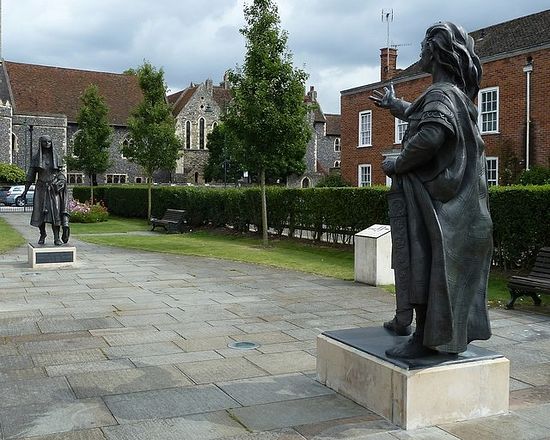 Bronze statues of Sts. Ethelbert and Bertha by former St. Augustine's Abbey in Canterbury (photo by Rob Farrow)
Bronze statues of Sts. Ethelbert and Bertha by former St. Augustine's Abbey in Canterbury (photo by Rob Farrow)
The medieval monastery was so large that it could be compared with the present huge Canterbury Cathedral. Unfortunately, it was dissolved by Henry VIII in 1538 and gradually ruined—after over 900 years of permanent monastic life, education and learning on this site. Now the ruins are cared for by English Heritage. Large-scale excavation work was carried out here recently and there is a museum/visitors’ center nearby that tells the story of this site—indeed one of the most significant sites in English history. Remains of the Church of Sts. Peter and Paul and that of St. Pancras can be distinguished among the ruins. Big bronze statues of Sts. Ethelbert and Bertha stand by the ruins. This is a very holy place also because more early saints were buried here even than at the Cathedral. Lately English Heritage has put markers (some of them symbolic) on the supposed graves of the early saints on the territory of the abbey. (Who knows, maybe the relics of some still lie in the ground under them).
The names of the saints buried at the St. Augustine’s abbey are: St. Augustine (first Archbishop of Canterbury), St. Laurence (second Archbishop of Canterbury), St. Mellitus (third Archbishop of Canterbury), St. Justus (fourth Archbishop of Canterbury), St. Honorius (fifth Archbishop of Canterbury), St. Deusdedit (Frithona in baptism: the first English-born and sixth Archbishop of Canterbury; + 664), St. Theodore of Tarsus (eighth Archbishop of Canterbury; + 690), St. Berhtwald (ninth Archbishop of Canterbury; + 731), Tatwine (tenth Archbishop of Canterbury; + 734), St. Nothelm (eleventh Archbishop of Canterbury; + 739), St. Jambert (fourteenth Archbishop of Canterbury; + 792), St. Hadrian of Canterbury, St. Ethelbert of Kent, St. Bertha of Kent, St. Mildred of Minster on Thanet (d. early eighth century; some of her relics were translated here in the first half of the eleventh century to rescue them from the pagan Danes), St. Mildgyth (St. Mildred’s sister, late seventh century).
The Cathedral of Christ the Savior in Canterbury, the current edifice of which is mainly from the twelfth century and built of Caen stone, is one of the most visited buildings in England, and the historic heart of the English land. The first Cathedral was built by St. Augustine by the year 602. Not long ago part of the Saxon building was discovered under the nave of the present Cathedral. The earliest part of the Cathedral is the crypt—some of it is from the eleventh century. The Cathedral has very many memorials and artefacts, though most of its treasures were barbarously destroyed during the Reformation initiated by Henry VIII nearly 500 years ago. The Cathedral precincts are entered through the impressive Christ Church gates with the splendid figure of Christ above you. The west towers of the Cathedral along with the famous Bell Harry Tower are magnificent. The beautiful huge West Window of the Cathedral is reputedly the oldest surviving stained glass in England (dating to the 1170s).
The twelfth-century murals inside St. Gabriel’s Chapel depict scenes from the life of St. John the Baptist. The high altar at the end of the Cathedral choir is dedicated to St. Thomas a Becket who was murdered in 1170 by knights of King Henry II (the latter then tried to atone for his sin, walking to the Cathedral as a simple pilgrim, praying for his forgiveness at Becket’s tomb and even allowing the Canterbury brethren to whip him). On both sides of the high altar are markers showing the sites of the former shrines of Sts. Dunstan and Alphege, great Orthodox Archbishops of Canterbury. Many sites within the Cathedral are still dedicated to the memory of Thomas a Becket, who is venerated by the Catholic Church—his shrine at this Cathedral attracted millions of pilgrims in the Middle Ages, as he was the most venerated Catholic saint of England and one of the most venerated post-schism saints in the whole of Western Europe. Though his shrine and major relics were destroyed during the Reformation, a tiny portion of his relics still survives at the Catholic Church of Thomas a Becket in Canterbury to this day.
Among other treasures of the Cathedral are thirteenth-century stained glass windows with images of various saints (for example, a twelfth-century image of St. Paul the Apostle with a snake), depictions from the life of Christ and, notably, the thirteenth-century Purbeck “St. Augustine’s Chair” on which each Archbishop of Canterbury is officially enthroned. There is also a remarkable chapel dedicated to all the modern martyrs of major Christian denominations, called “the Corona Chapel”. Here is the list of the saints buried within Canterbury Cathedral (nobody knows whether the relics of any of them still rest concealed there or not, though the Lord may reveal it one day):
St. Cuthbert (twelfth Archbishop of Canterbury; +760), St. Bregwine (thirteenth Archbishop of Canterbury; +764), St. Ethelhard (fifteenth Archbishop of Canterbury; +805), St. Plegmund (twentieth Archbishop of Canterbury; + c.923), St. Athelm, or Athelhelm (twenty-first Archbishop of Canterbury; + c. 927), St. Odo, or Oda the Good, or Severe (twenty-third Archbishop of Canterbury; + c.958), St. Dunstan (twenty-sixth Archbishop of Canterbury; + 988), St. Aelfric (twenty-ninth Archbishop of Canterbury; not to be confused with the learned abbot, scholar and spiritual writer Aelfric of Eynsham; +1005), St. Alphege the Martyr (thirtieth Archbishop of Canterbury; +1012), St. Aethelnoth the Good (thirty-second Archbishop of Canterbury; +1038), St. Eadsige (thirty-third Archbishop of Canterbury; + c.1050), St. Swithin of Winchester (his head relic rested here; +862), St. Wulgan (an eighth century British missionary who enlightened the Atrebati in Gaul and lived as hermit in Arras; a portion of his relics rested here). As we can see, twenty-two early (and Orthodox) Archbishops of Canterbury were canonized—and St. Augustine is at the head of them. During the Second World War Canterbury was heavily damaged by Luftwaffe bombs but the cathedral was rescued by the city residents and, of course, through intercession of St. Augustine. As we know, a similar miraculous event happened in Durham in 1943: St. Cuthbert whose relics rest there saved the city of Durham and its cathedral from Luftwaffe bombs by hiding them in thick fog!
“St. Augustine’s Way” is a pilgrimage trail from Ramsgate to Canterbury embracing some 20 miles and covering places associated with St. Augustine. It begins from the Catholic church-shrine of St. Augustine in Ramsgate and passes, among other places, through the village of Cliffsend (according to one version, it was here that the saint first landed in England; the Saxon leaders Hengist and Horsa also landed here in 449 A.D. to settle in England), St. Augustine’s cross, Minster-on-Thanet, and Fordwich near Canterbury (claiming to be the smallest English town; it has the old St. Mary’s church which houses a tomb believed to be the one that once contained St. Augustine’s relics).
Holy Hierarch Augustine, pray to God for us!

